High-Voltage Drivers Based on Forming Lines with Extended Quasi-Rectangular Pulses for High-Power Microwave Oscillators
Abstract
:1. Introduction
2. Basic Properties of a Single FL
3. Results
3.1. Theoretical Grounds for Extended FLs
3.1.1. Double-Width Forming Line
3.1.2. Triple-Width Forming Line
3.1.3. Forming Line with k-Fold Extension
3.2. Simulation Results for TWFL
3.3. Laboratory Model of SINUS-Type Driver Based on TWFL
4. Discussion
5. Conclusions
Author Contributions
Funding
Conflicts of Interest
References
- Mesyats, G.A.; Korovin, S.D.; Gunin, A.V.; Gubanov, V.P.; Stepchenko, A.S.; Grishin, D.M.; Landl, V.F.; Alekseenko, P.I. Repetitively pulsed high-current accelerators with transformer charging of forming lines. Laser Part. Beams 2003, 21, 197–209. [Google Scholar] [CrossRef]
- Zhang, H.; Shu, T.; Liu, S.; Zhang, Z.; Song, L.; Zhang, H. A Compact Modular 5 GW Pulse PFN-Marx Generator for Driving HPM Source. Electronics 2021, 10, 545. [Google Scholar] [CrossRef]
- Lassale, F.; Morell, A.; Loyen, A.; Chanconie, T.; Roques, B.; Toury, M.; Vezinet, R. Development and test of a 400-kV PFN Marx with compactness and rise time optimization. IEEE Trans. Plasma Sci. 2018, 46, 3313–3319. [Google Scholar] [CrossRef]
- Krasik, Y.E.; Dunaevsky, A.; Krokhmal, A.; Felsteiner, J.; Gunin, A.V.; Pegel, I.V.; Korovin, S.D. Emission properties of different cathodes at E≤105 V/cm. J. Appl. Phys. 2001, 89, 2379–2399. [Google Scholar] [CrossRef]
- Afanas’ev, K.V.; Bykov, N.M.; Gubanov, V.P.; El’chaninov, A.A.; Klimov, A.I.; Korovin, S.D.; Rostov, V.V.; Stepchenko, A.S. A high-power periodic nanosecond pulse source of coherent 8-cm electromagnetic radiation. Tech. Phys. Lett. 2006, 32, 925–927. [Google Scholar] [CrossRef]
- Shafir, G.; Kreif, M.; Gleizer, J.Z.; Krasik, Y.E.; Gunin, A.V.; Kutenkov, O.P.; Pegel, I.V.; Rostov, V.V. Experimental research of different plasma cathodes for generation of high-current electron beams. J. Appl. Phys. 2015, 118, 193302. [Google Scholar] [CrossRef]
- Belomyttsev, S.Y.; Rostov, V.V.; Romanchenko, I.V.; Shunailov, S.A.; Kolomiets, M.D.; Mesyats, G.A.; Sharypov, K.A.; Shpak, V.G.; Ulmaskulov, M.R.; Yalandin, M.I. Magnetically insulated coaxial vacuum diode with partial space-charge-limited explosive emission from edge cathode. J. Appl. Phys. 2016, 119, 023304. [Google Scholar] [CrossRef]
- Belomyttsev, S.Y.; Korovin, S.D.; Pegel, I.V. Effect of the expanding explosive-emission centers plasma on the impedance of a high-current diode. IEEE Trans. Plasma Sci. 1999, 27, 1572–1577. [Google Scholar] [CrossRef]
- Rostov, V.V.; El’chaninov, A.A.; Klimov, A.I.; Konev, V.Y.; Romanchenko, I.V.; Sharypov, K.A.; Shunailov, S.A.; Ul’maskulov, M.R.; Yalandin, M.I. Phase control in parallel channels of shock-excited microwave nanosecond oscillators. IEEE Trans. Plasma Sci. 2013, 41, 2735–2741. [Google Scholar] [CrossRef]
- Yalandin, M.I.; Reutova, A.G.; Ulmaskulov, M.R.; Sharypov, K.A.; Shpak, V.G.; Shunailov, S.A.; Klimov, A.I.; Rostov, V.V.; Mesyats, G.A. Picosecond stability of injection of parallel high-current electron beams. Tech. Phys. Lett. 2009, 35, 804–807. [Google Scholar] [CrossRef]
- Rostov, V.V.; Elchaninov, A.A.; Romanchenko, I.V.; Yalandin, M.I. A coherent two-channel source of Cherenkov superradiance pulses. Appl. Phys. Lett. 2012, 100, 224102. [Google Scholar] [CrossRef]
- Rostov, V.V.; Elchaninov, A.A.; Romanchenko, I.V.; Shunailov, S.A.; Ulmaskulov, M.R.; Sharypov, K.A.; Shpak, V.G.; Rukin, S.N.; Yalandin, M.I. Two-channel generator of the 8-mm wavelength range for radiation with subgigawatt power level pulses. Radiophys. Quantum Electron. 2014, 56, 475–491. [Google Scholar] [CrossRef]
- Tot’meninov, E.M.; Vykhodsev, P.V.; Gunin, A.V.; Klimov, A.I.; Rostov, V.V. Increase in the energy efficiency of a pulsed-periodic relativistic backward wave oscillator with a modulating resonant reflector. Tech. Phys. 2014, 59, 428–433. [Google Scholar] [CrossRef]
- Rostov, V.V.; Tsygankov, R.V.; Vykhodsev, P.V.; Konev, V.Y.; Stepchenko, A.S. Stable operation of a repetitively pulsed X-band relativistic backward wave oscillator. IEEE Electron Device Lett. 2021, 42, 935–938. [Google Scholar] [CrossRef]
- Rostov, V.V.; Gunin, A.V.; Tsygankov, R.V.; Romanchenko, I.V.; Yalandin, M.I. Two-wave Cherenkov oscillator with moderately oversized slow-wave structure. IEEE Trans. Plasma Sci. 2017, 46, 33–42. [Google Scholar] [CrossRef]
- Sun, J.; Chen, C. Research on 3-GW repetitively operating relativistic backward wave oscillator. IEEE Trans. Plasma Sci. 2020, 48, 3535–3543. [Google Scholar] [CrossRef]
- Bratman, V.L.; Denisov, G.G.; Kolchugin, B.D.; Korovin, S.D.; Polevin, S.D.; Rostov, V.V. Powerful millimeter-wave generators based on the stimulated Cerenkov radiation of relativistic electron beams. Int. J. Infrared Millim. Waves. 1984, 5, 1311–1332. [Google Scholar] [CrossRef]
- Denisov, G.G.; Smorgonsky, A.V.; Gubanov, V.P.; Korovin, S.D.; Rostov, V.V.; Yalandin, M.I. Powerful electromagnetic millimeter-wave oscillations produced by stimulated scattering of microwave radiation by relativistic electron beams. Int. J. Infrared Millim. Waves. 1984, 5, 1389–1403. [Google Scholar] [CrossRef]
- Korovin, S.D.; Rostov, V.V.; Smorgonsky, A.V. Pulse-periodic relativistic carsinotron (in Russian). Izv. Vyssh. Uchebn. Zaved. Radiofiz. 1986, 29, 1278–1280. [Google Scholar]
- Gubanov, V.P.; Korovin, S.D.; Pegel, I.V.; Roitman, A.M.; Rostov, V.V.; Stepchenko, A.S. Compact 1000 pps high-voltage nanosecond pulse generator. IEEE Trans. Plasma Sci. 1997, 25, 258–265. [Google Scholar] [CrossRef]
- Gunin, A.V.; Landl’, V.F.; Korovin, S.D.; Mesyats, G.A.; Rostov, V.V. Long-lived explosive-emission cathode for high-power microwave generators. Tech. Phys. Lett. 1999, 25, 922–926. [Google Scholar] [CrossRef]
- Zhang, J.; Jin, Z.-X.; Yang, J.-H.; Zhong, H.-H.; Shu, T.; Zhang, J.-D.; Qian, B.-L.; Yuan, C.-W.; Li, Z.-Q.; Fan, Y.-W.; et al. Recent advance in long-pulse HPM sources with repetitive operation in S.-, C.-, and X-bands. IEEE Trans. Plasma Sci. 2011, 39, 1438–1445. [Google Scholar] [CrossRef]
- Liu, S.; Su, J.-C.; Zhang, X.; Pan, Y.-F.; Fan, H.-Y.; Fan, X.-L. A Tesla-type long-pulse generator with wide flat-top width based on double-width pulse-forming line. Laser Part. Beams 2018, 36, 115–120. [Google Scholar] [CrossRef]
- Eltchaninov, A.S.; Zagulov, F.Y.; Korovin, S.D.; Mesyats, G.A. Electron beam accelerator with high pulse recurrence frequency. In Proceedings of the 3rd International Topical Conference on High Power Electron and Ion Beams, Novosibirsk, Russia, 3–6 July 1979; pp. 191–197. [Google Scholar]
- Mesyats, G.A. Pulsed Power, 1st ed.; Springer: Boston, MA, USA, 2005. [Google Scholar] [CrossRef]
- Korovin, S.D.; Rostov, V.V.; Polevin, S.D.; Pegel, I.V.; Schamiloglu, E.; Fuks, M.I.; Barker, R.J. Pulsed power-driven high-power microwave sources. Proc. IEEE 2004, 92, 1082–1095. [Google Scholar] [CrossRef]
- Mesyats, G.A.; Korovin, S.D.; Rostov, V.V.; Shpak, V.G.; Yalandin, M.I. The RADAN series of compact pulsed power generators and their applications. Proc. IEEE 2004, 92, 1166–1179. [Google Scholar] [CrossRef]
- Zhang, Z.; Zhang, J.; Qian, B.; Liu, C.; Xun, T.; Zhang, H.; Liang, B. Compact rep-rate GW pulsed generator based on forming line with built-in high-coupling transformer. IEEE Trans. Plasma Sci. 2014, 42, 241–248. [Google Scholar] [CrossRef]
- Liu, S.F.; Zhang, Z.C.; Wang, Y.W.; Zhang, J.D.; Xiao, L.A.; Liang, B.; Li, D.G. Low-impedance high-power pulsed generator based on forming line with built-in Tesla transformer. Rev. Sci. Instrum. 2021, 92, 084705. [Google Scholar] [CrossRef]
- Martin, J.C. Nanosecond pulse techniques. Proc. IEEE 1992, 80, 934–945. [Google Scholar] [CrossRef]
- Ushakov, V.Y. Behavior of Liquids in Strong Electric Fields. In Impulse Breakdown of Liquids; Power Systems; Springer: Berlin/Heidelberg, Germany, 2007; pp. 1–51. [Google Scholar] [CrossRef]
- Korovin, S.D.; Rostov, V.V.; Tot’meninov, E.M. A relativistic backward wave oscillator with a modulating resonance reflector. Tech. Phys. Lett. 2005, 31, 411–413. [Google Scholar] [CrossRef]
- Tot’meninov, E.M.; Klimov, A.I.; Kurkan, I.K.; Polevin, S.D.; Rostov, V.V. Repetitively pulsed relativistic BWO with enhanced mechanical frequency tunability. IEEE Trans. Plasma Sci. 2008, 36, 2609–2612. [Google Scholar] [CrossRef]
- Liu, S.; Su, J.; Fan, X. Note: A high-energy-density tesla-type pulse generator with novel insulating oil. Rev. Sci. Instrum. 2017, 88, 096101. [Google Scholar] [CrossRef] [PubMed]
- Martin, D.; Wang, Z.D. Statistical analysis of the AC breakdown voltages of ester based transformer oils. IEEE Trans. Dielectr. Electr. Insul. 2008, 15, 1044–1050. [Google Scholar] [CrossRef]
- Ulmaskulov, M.R.; Pedos, M.S.; Rukin, S.N.; Sharypov, K.A.; Shpak, V.G.; Shunailov, S.A.; Yalandin, M.I.; Romanchenko, I.V.; Rostov, V.V. High repetition rate multi-channel source of high-power rf-modulated pulses. Rev. Sci. Instrum. 2015, 86, 074702. [Google Scholar] [CrossRef] [PubMed]
- Romanchenko, I.V.; Ulmaskulov, M.R.; Sharypov, K.A.; Shunailov, S.A.; Shpak, V.G.; Yalandin, M.I.; Pedos, M.S.; Rukin, S.N.; Konev, V.Y.; Rostov, V.V. Four channel high power rf source with beam steering based on gyromagnetic nonlinear transmission lines. Rev. Sci. Instrum. 2017, 88, 054703. [Google Scholar] [CrossRef]



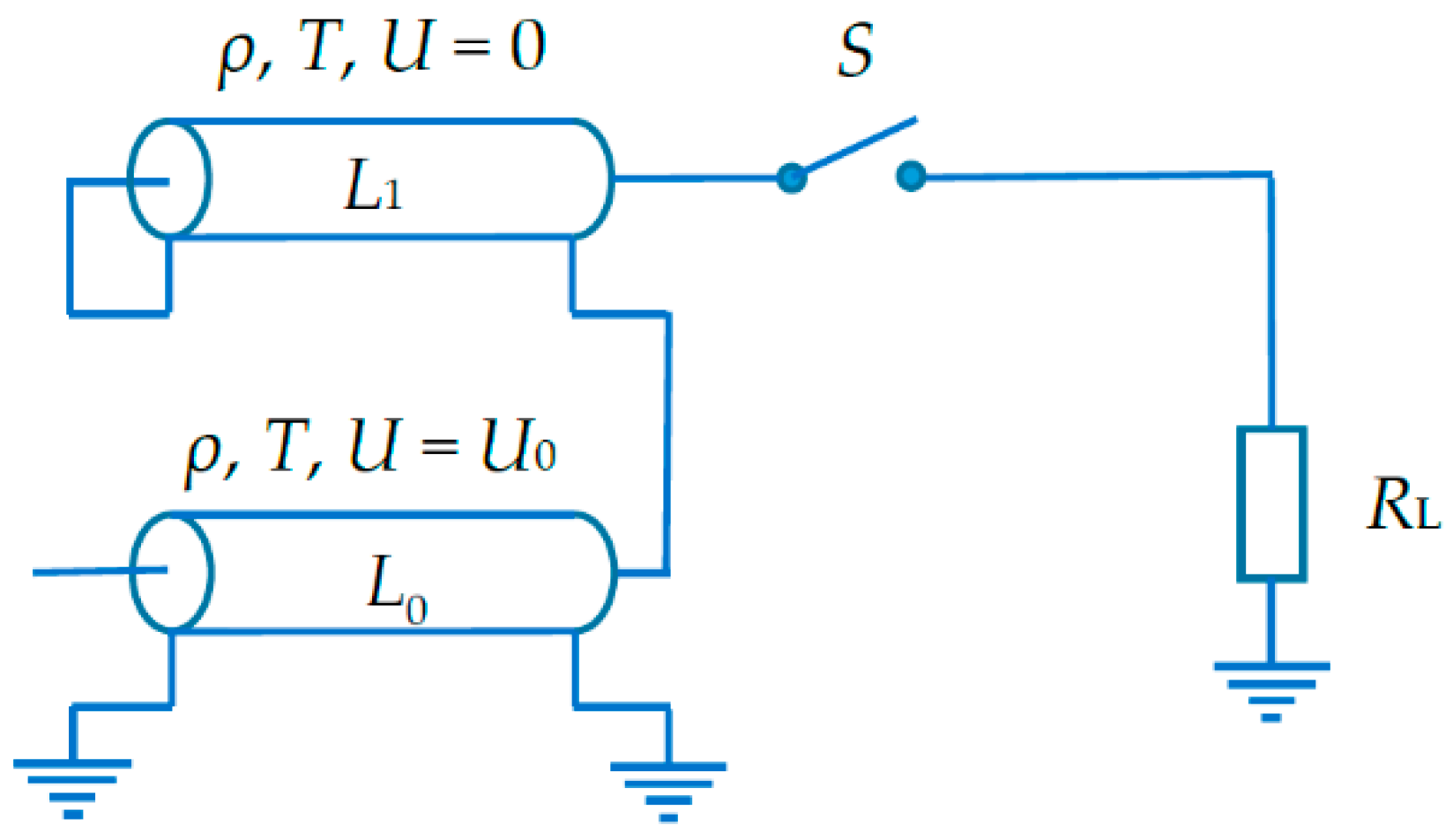

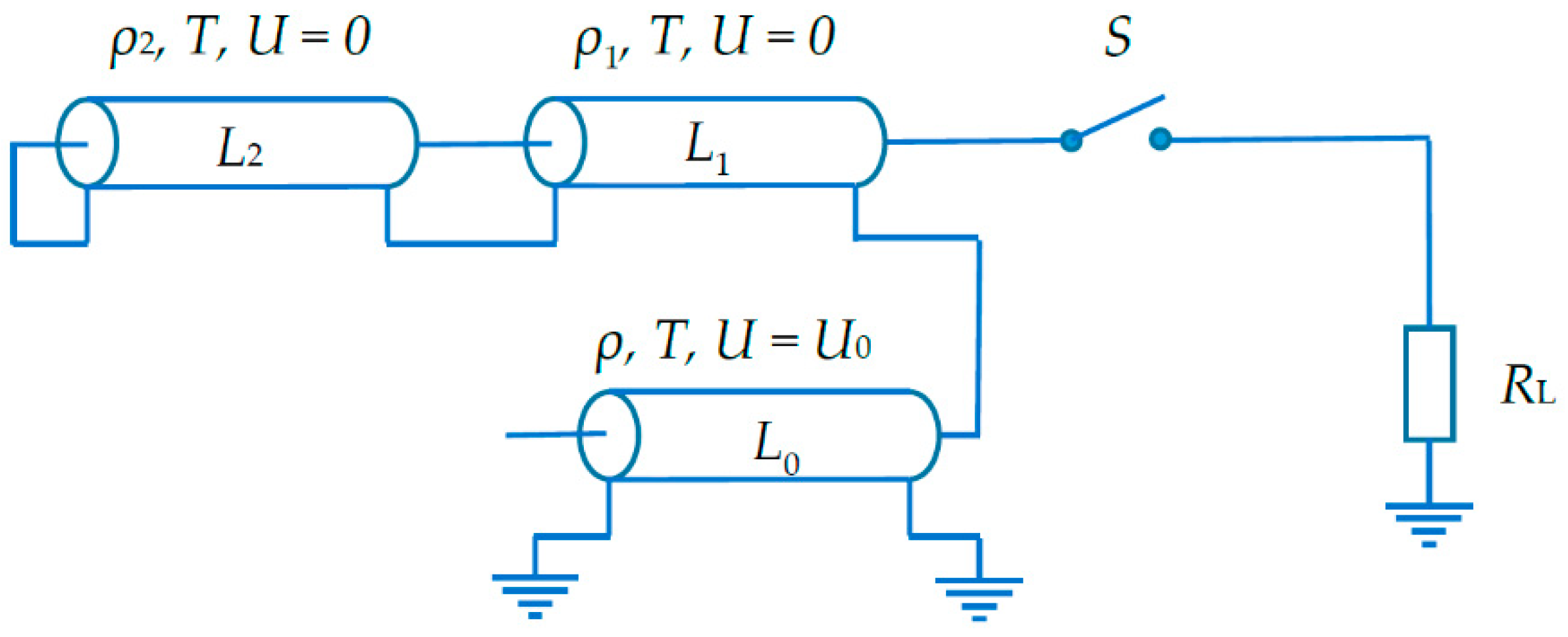



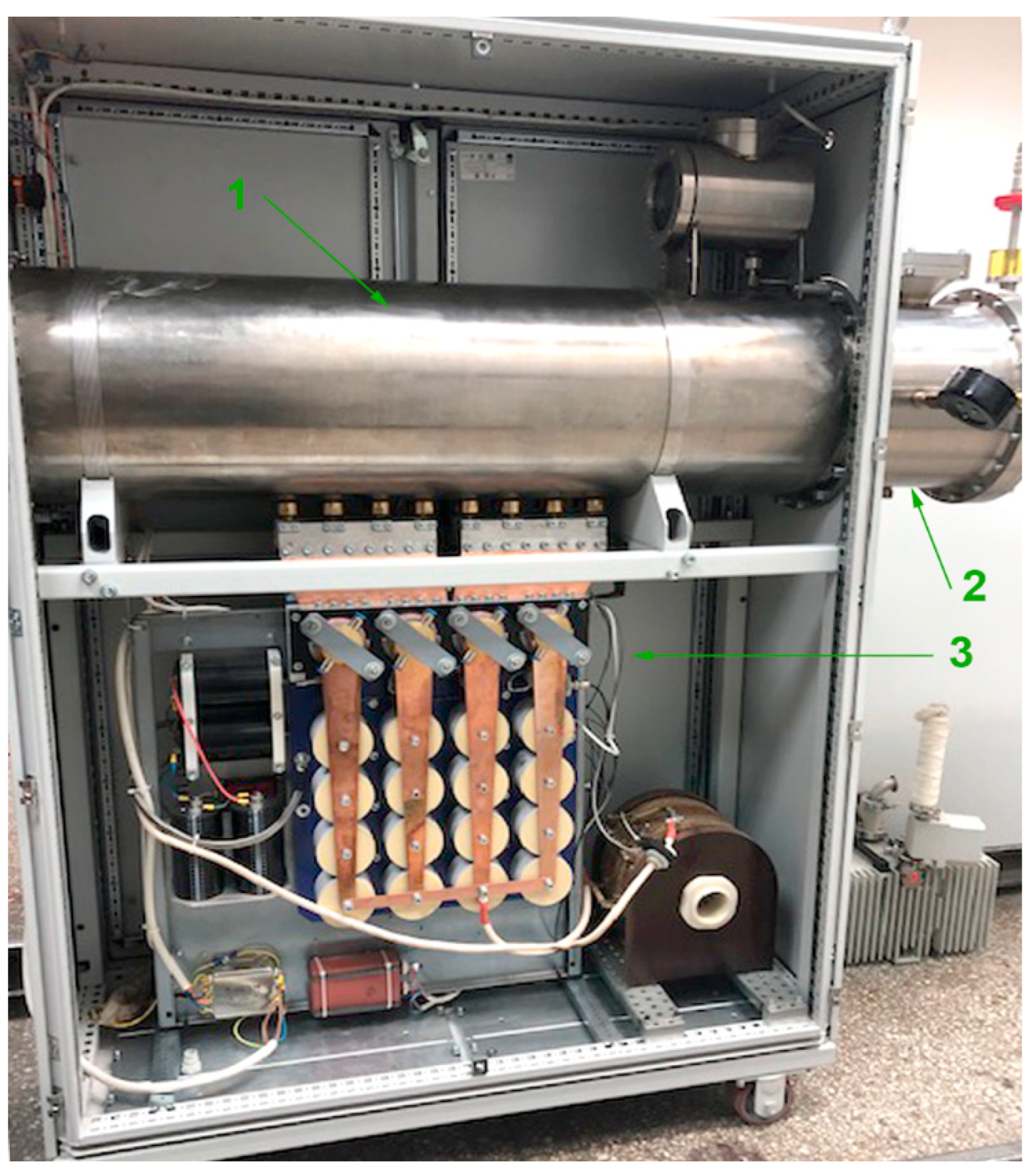
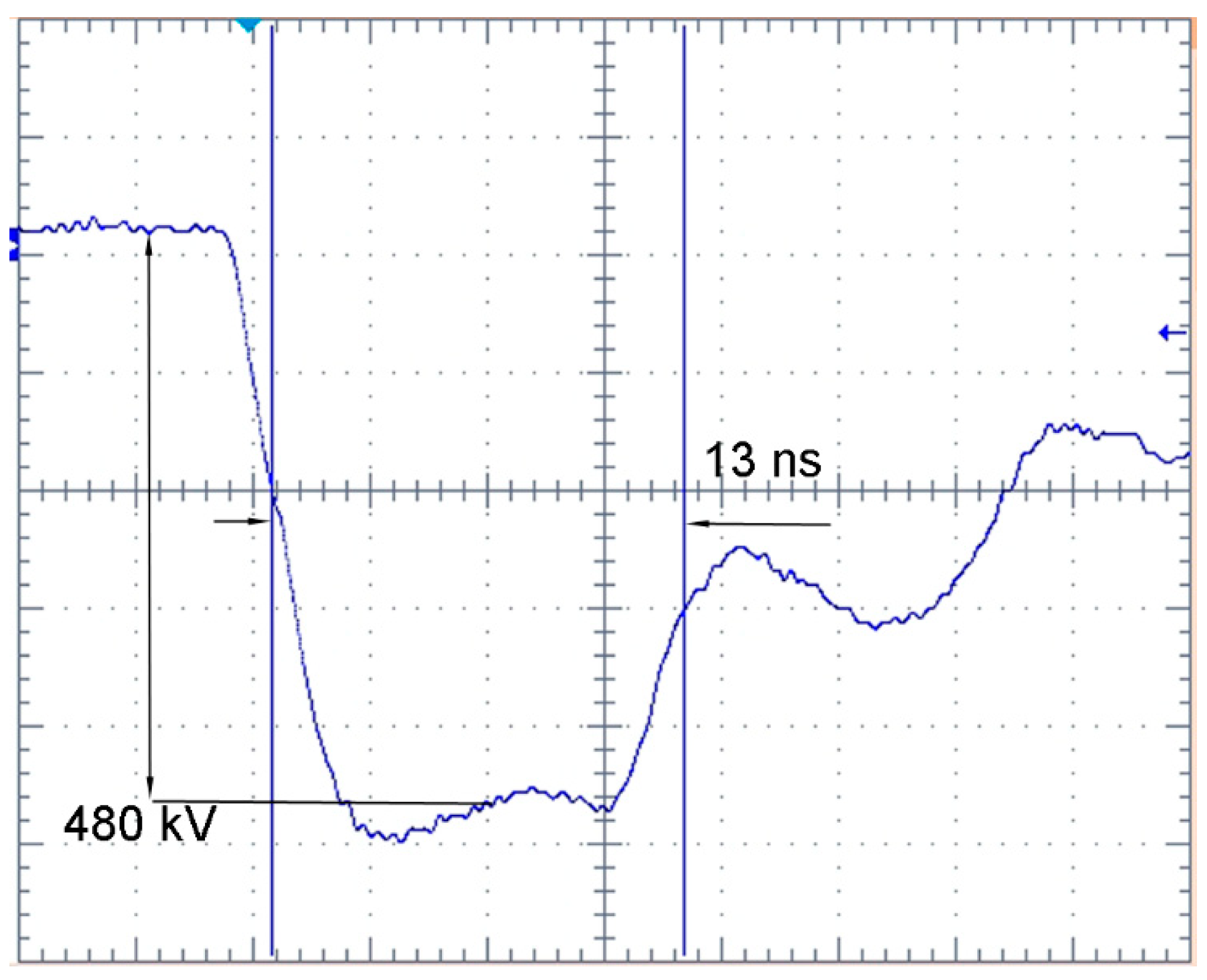
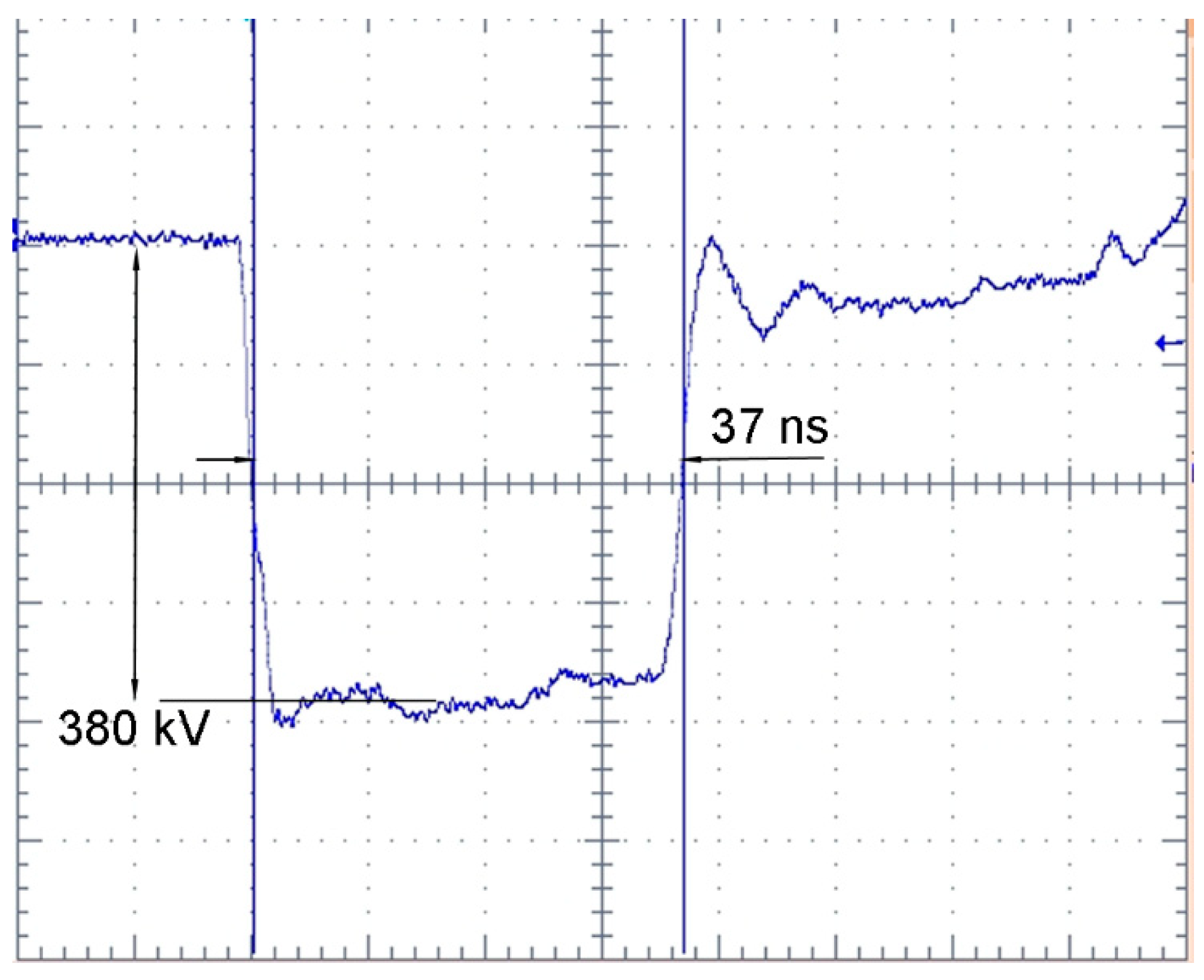
| t | UL0/U0 | UL1/U0 | UL2/U0 |
|---|---|---|---|
| 0 | 1 | 0 | 0 |
| T | 5/6 | −1/3 | 0 |
| 2T | 2/3 | −1/6 | −1/6 |
| 3T | 1/2 | 0 | 0 |
| 4T | 1/3 | 1/6 | 1/6 |
| 5T | 1/6 | 1/3 | 1/3 |
| 6T | 0 | 0 | 0 |
Publisher’s Note: MDPI stays neutral with regard to jurisdictional claims in published maps and institutional affiliations. |
© 2022 by the authors. Licensee MDPI, Basel, Switzerland. This article is an open access article distributed under the terms and conditions of the Creative Commons Attribution (CC BY) license (https://creativecommons.org/licenses/by/4.0/).
Share and Cite
Rostov, V.V.; Stepchenko, A.S.; Vykhodtsev, P.V.; Tsygankov, R.V. High-Voltage Drivers Based on Forming Lines with Extended Quasi-Rectangular Pulses for High-Power Microwave Oscillators. Electronics 2022, 11, 406. https://doi.org/10.3390/electronics11030406
Rostov VV, Stepchenko AS, Vykhodtsev PV, Tsygankov RV. High-Voltage Drivers Based on Forming Lines with Extended Quasi-Rectangular Pulses for High-Power Microwave Oscillators. Electronics. 2022; 11(3):406. https://doi.org/10.3390/electronics11030406
Chicago/Turabian StyleRostov, Vladislav V., Alexei S. Stepchenko, Pavel V. Vykhodtsev, and Ruslan V. Tsygankov. 2022. "High-Voltage Drivers Based on Forming Lines with Extended Quasi-Rectangular Pulses for High-Power Microwave Oscillators" Electronics 11, no. 3: 406. https://doi.org/10.3390/electronics11030406
APA StyleRostov, V. V., Stepchenko, A. S., Vykhodtsev, P. V., & Tsygankov, R. V. (2022). High-Voltage Drivers Based on Forming Lines with Extended Quasi-Rectangular Pulses for High-Power Microwave Oscillators. Electronics, 11(3), 406. https://doi.org/10.3390/electronics11030406







